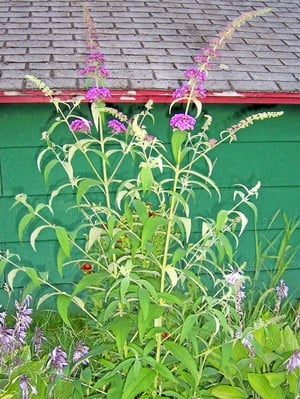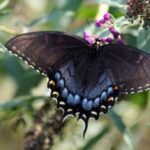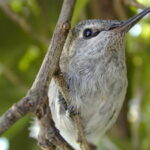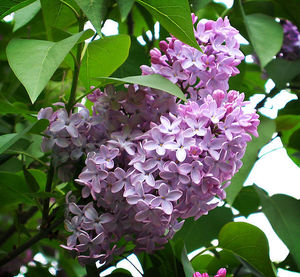If a gardener wishes to fill a space in his garden with an easy-care plant that will attract butterflies, nothing could be more beautiful than a butterfly bush. The butterfly bush or species Buddleia davidii originally grew in the southwestern Chinese province of Yunnan. In the early 1900’s, this perennial shrub was introduced into European gardens. This robust and resilient plant is recommended for USDA hardiness zones 5-11. It sometimes is called its nickname ‘summer lilacs.’
What Does It Look Like?
The butterfly bush is a very popular shrub that can easily tower over the other plants in the garden with its height of anywhere from six to fifteen feet. It can fill a garden space with its growth from four to fifteen feet in width. For this reason three or four butterfly bushes could be planted in a row two or three feet apart to form a dense but lovely privacy hedge.
The small leaves of the butterfly bush vary from grayish-green to dark green. The stems branching off from the main stems tend to grow in a disorderly manner. Cultivars for the garden such as ‘Guinevere’ are being developed with a more compact and orderly growth pattern. These grow to only four or five feet in height.
The blossoms are the main attraction of the butterfly bush. They are beautiful as well as a rich source of nectar for butterflies, bees, and hummingbirds. Each spire-shaped cluster is composed of several tiny blooms which open slowly, starting from the base of the spire to the tip. Different garden varieties produce different flower spike lengths. The cultivars Golden and Dwarf Blue have spires three to five inches in length. Black Knight, Royal Red, Pink Delight, Royal Blue, ilight, another butterfly bush cultivar, grows to six to eight feet in height with dark purple blooms perfect for cut or dried flower bouquets. It is a recommended choice for small gardens.
Two cultivars with white blossoms, White Profusion and White Bouquet, both have growth habits that are more upright and less spread out. White Profusion grows to eight feet in height and blooms in late spring to late summer. The underside of its leaves has a silvery white appearance.
Planted up against a white picket fence, a butterfly bush can give an effect like one of the cottage gardens seen in some parts of England.
A butterfly bush could be planted to the side of one of the windows of the house. In this way, it would provide a little shade besides allowing some glimpses and possible photo opportunities of the insects and hummingbirds attracted to it.
It can be planted near the bottom of a small incline to conceal the slope.
When the butterfly bush serves as a backdrop in the small garden, other perennials attractive to butterflies may be planted around it. Perennials which could fill in the remaining spaces, in descending order from tallest to shortest include Joe pyeweed and tall ironweed (six to eight feet tall), common milkweed (three to four feet), asters (two to four feet), purple coneflower (two to three feet), goldenrod (up to two and a half feet), coreopsis (one to two feet), and viola odorata (six to twelve inches). All of these are known to be wonderful attractions for butterflies.
How Does One Take Proper Care of a Butterfly Bush?
Plant your butterfly bush where it will receive full sun. The hottest sun will not dull the flowers’ hues or wilt the leaves. It can withstand some drought conditions. The garden soil in which it is planted should receive good drainage and have a pH of between 6.6 to 7.8 (neutral to slightly alkaline). The soil does not require enrichment. Water butterfly bushes once or twice a month, dependant upon the rainfall during that time period. The bushes should not be overwatered.
One of the biggest questions a gardener has when faced with the rampant growth habit of many cultivars is how he can prune the butterfly bush and control some of its bushiness. Many cultivars require a once or twice a year pruning but some varieties like Dwarf Blue do not. Most cultivars should be pruned in late winter by either thinning the side stems or cutting the bush almost to the ground. This depends upon what USDA zone the gardener is in. In zones 8 to 11 the butterfly bush will not lose its leaves and should just be thinned. In zones 5 and 6 the bush becomes dormant and can be cut to the ground after the first frost. Place three to six inches of mulch over the crown of the bush to protect it. Rather than damaging the plant, a good pruning will encourage the blossoms to come back bigger and more vibrant. In the spring the butterfly bush can be pruned if the side branches are causing the top to droop. A butterfly bush can put on three to four feet of height in its first year of growth.
Are Butterfly Bushes Invasive?
In Europe, butterfly bushes grow in the wild. Spain, France, and Switzerland have programs in place to attempt to curtail the unrestrained growth of butterfly bushes. The bushes grow so abundantly along railroad tracks that they become a safety hazard. Natural Asiatic insect species which kept the bushes under control in China have not yet adapted to European climates.
In the United States and especially in the Pacific Northwest, butterfly bushes have proven to be a very aggressive invasive species. In 2004, Buddleia davidii was named a Class B noxious weed by the Oregon Department of Agriculture.
Carol Savonen of Oregon State University recommends the following to keep butterfly bushes in the home garden from becoming invasive:
Deadhead, or prune, all spent bloom spires. Unlike many other flowers, butterfly bush flowers do not drop to the ground when spent. Since the seed is released in the spring, deadheading should be done in the fall.
Burn or shred and compost all pruned portions of the butterfly bush.
Get rid of new seedlings from the original bush by digging them up. Do not give them away.
Choose a cultivar for the garden that is known to produce fewer seeds. ‘Summer Rose’ or ‘Orchid Beauty’ are examples of these.
Butterfly bushes can make your garden a showcase of beauty and attractive to butterflies, bees, and hummingbirds but require some care to keep them from becoming just another noxious weed.
Resources:
Helmholtz Association of German Research Centres. “When the Butterfly Bush Blossoms.” [Online] http://www.physorg.com/news131116957.html.
Mountain Valley Growers, Inc. “Butterfly Bushes.” [Online] http://www.mountainvalleygrowers.com/mvv2-94.htm.
Savonen, Carol. “How to keep butterfly bush from spreading noxiously.” Oregon State University. [Online] http://extension.oregonstate.edu/news/story.php?S_No=770&storyType;=garde
Beaulieu, David. Designing Butterfly Gardens: Sun, Moisture, Shelter. [Online] http://landscaping.about.com/cs/forthebirds/a/butterfly_plant.htm
Hirt’s Gardens. “Plants: Buddleia davidii ‘Guinevere’-Butterfly Bush.” [Online] http://www.about-garden.com/a/en/2234-buddleia-davidii-guinevere-butterfly-bush/








